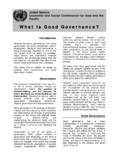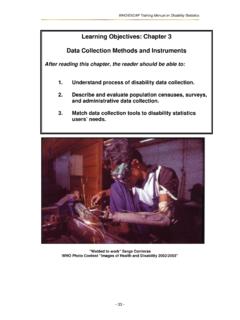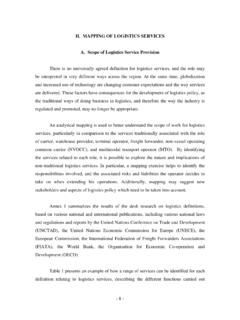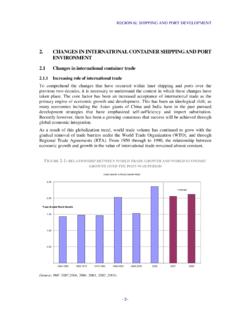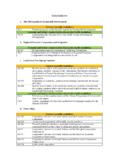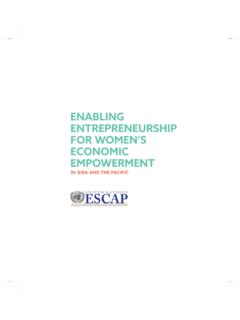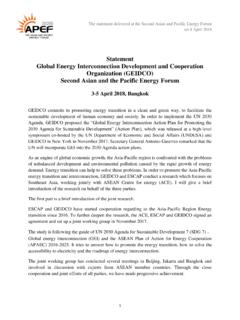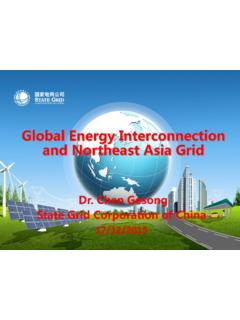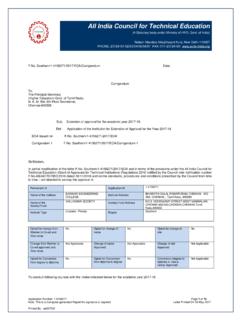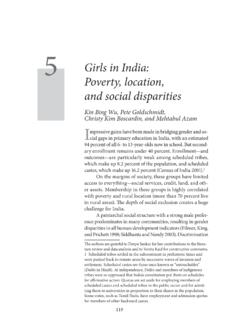Transcription of India and the MDGs - unescap.org
1 India and the MDGsTo w a rd s a s u s t a i n a b l e f u t u re f o r a l lIndia has made notable progress in achieving poverty reduction and other Millennium Development Goals (MDGs) since their adoption at the turn of the century but this progress has been uneven and millions continue to remain trapped in extreme poverty. As the MDGs reach their deadline, and world leaders prepare to adopt new Sustainable Development Goals at the United Nations General Assembly in 2015, it is an opportune moment to make an assessment of India s achievement of MDGs and lessons learned for the , the responsibility of steering development in India has been passed on to a new Government with a decisive mandate for change. Through its principle of Sabka Saath, Sabka Vikas, and its policy actions since assuming office, more than ever before, the Government is calling for improved sanitation, health, education , financial inclusion, security and dignity of all, especially women.
2 It is also prioritizing environmental protection by treating the challenge of climate change adaptation as an opportunity rather than a problem. There seems to be a remarkable convergence of vision underlying the sustainable development goals and those of the Government, although it remains to be seen how effectively it implements its new strategic direction to provide a life of dignity to and the MDGs: Towards a Sustainable Future for All makes an assessment of achievement of MDGs by India over the past 14 years and draws policy lessons for accelerating progress for closing the gaps and carrying momentum post-2015 to end poverty and other deprivations and provide sustainable prosperity for all. Prepared by the South and South-West Asia Office of the United Nations Economic and Social Commission for Asia and the Pacific (UNESCAP-SSWA), on behalf of the United Nations Country Team in United Nations, February 2015 This analysis has been prepared by a UNESCAP team led by Nagesh Kumar, Head of UNESCAP-SSWA Office and comprising Ivana Brnovic, Shiladitya Chatterjee (adviser), Christopher Garroway (since moved to UNCTAD), Matthew Hammill, Swayamsiddha Panda & Wanphen UNESCAP team is grateful to Ms.
3 Lise Grande, the UN Resident Coordinator in India (until January 2015), who conceived the report as a UN Country Team activity and invited UNESCAP SSWA office to lead it. Valuable inputs for the analysis were received from members of UNCT task teams led by Cristina Albertin (UNODC), Shigeru Aoyagi (UNESCO), Louis-Georges Arsenault (UNICEF), Dominik Bartsch (UNHCR), Jaco Cilliars (UNDP), Torben Due (WFP), Ayumi Fujino (UNIDO), Peter E. Kenmore (FAO), Kiran Mehra-Kerpelman (UNIC), Frederika Meijer (UNFPA), Nata Menabde (WHO), Tine Staermose (ILO), Rebecca Tavares (UN WOMEN), and Oussama Tawil (UNAIDS).The analysis benefited from extensive comments of individuals acting as expert reviewers namely: Naresh C. Saxena (UNDP), Shiva Kumar (UNDP) and Ramgopal Agarwala of Pehle India Foundation. Radhika Kaul-Batra of the UN Resident Coordinator s Office provided helpful inputs. The analysis and recommendations contained within do not necessarily reflect the official views of the United Nations, its agencies or its Member States.
4 This analysis was issued without formal : Ishan Khosla DesignCover Photo: UNICEF India / Dhiraj SinghInside Title Photo: CGIAR, accessed from byon behalf of the United Nations Country Team - IndiaIndia and the MDGsTowards a Sustainable Future for AllUNITED NATIONSI ndia and the MDGs: Towards a Sustainable Future for All The world is approaching a milestone for global development in 2015. As the Millennium Development Goals (MDGs) reach their December 2015 deadline, a new set of transformative and universal Sustainable Development Goals (SDGs) will be adopted by world leaders as a part of the Post 2015 Development Agenda at the United Nations General Assembly in September 2015. The new sustainable development agenda seeks to ensure that the momentum generated by the millennium development goals is carried forward beyond 2015 to achieve not just substantial reductions in poverty, hunger and other deprivations but finally end them to provide a life of dignity to all.
5 At this crucial juncture, the responsibility of steering development in India has been passed on to a new Government. It is now an opportune moment to take stock of the achievement of the MDGs in India and lessons learned that can be incorporated into the design and implementation of the sustainable development goals to build upon the unfinished MDG is now a remarkable convergence of vision underlying the priorities for the proposed SDGs and those of the new Government in India . Building on the MDGs, the SDGs propose to end poverty and deprivation in all forms, leaving no one behind, while making development economically, socially and environmentally sustainable. The Government of India has also adopted the principle of Sabka Sath, Sabka Vikas ( Together with All, Development for All ), and stated that the first claim on development belongs to the poor. More than ever before, the Government is calling for improved sanitation, health, education , financial inclusion, security and dignity of all, especially women.
6 The Government is simultaneously prioritizing improving environmental development with respect to water, air, soil and the biosphere by treating the challenge of climate change adaptation as an opportunity rather than a problem. In less than nine months since taking office, the Government has announced a variety of measures to accelerate the process of growth with equity and sustainability and shown its eagerness to learn from success stories in these areas in India and abroad. Yet a complete blueprint of how to achieve these goals in a time-bound fashion is still a work in this backdrop, this analysis has two main objectives. Looking back at India s experience with the MDGs, the analysis reviews MDG achievements and Goal-specific gaps at the national level. It also identifies key cross-cutting factors or drivers that helped There is now a remarkable convergence of vision underlying the priorities for the proposed SDGs and those of the new Government in India .
7 Building on the MDGs, the SDGs propose to end poverty and deprivation in all forms, leaving no one behind, while making development economically, socially and environmentally India and the MDGs: Towards a Sustainable Future for Allspur progress towards completing the MDGs, and outlines policy directions to accelerate performance in lagging areas. Looking ahead, the analysis reflects on the main development concerns that India will have to confront in the post-2015 period to achieve a better, more inclusive and sustainable s overall performance on the MDGsThe MDGs represent a core people-oriented development agenda. As a signatory to the historic Millennium Declaration adopted at the United Nations General Assembly in September 2000, India has remained committed to ending poverty and other deprivations. Achieving the MDGs is a core development challenge for India . India s new Government has reinforced this priority through the principle of Sabka Sath, Sabka Vikas and the Prime Minister, in his 2014 Independence Day speech, also urged Indians to work together towards overcoming poverty, gender inequality and the lack of sanitation, which are all crucial MDG has made notable progress towards reaching the MDGs but achievement across the Goals varies.
8 India has already achieved the target for reducing poverty by half (Goal 1) by official estimates and is close to doing so by international estimates. India has already achieved gender parity in primary school enrolment (Goal 3) and is likely to reach parity in secondary and tertiary education also by 2015. India is set to achieve reducing hunger by half (Goal 1); to reduce maternal mortality by three quarters (Goal 5); control of the spread of deadly diseases such as HIV/AIDS, malaria and tuberculosis (Goal 6); has increased forest cover and has halved the proportion of population without access to clean drinking water (Goal 7). But India is lagging behind on targets for achieving universal primary school enrolment and completion and achieving universal youth literacy by 2015 (Goal 2); empowering women through wage employment and political participation (Goal 3); reducing child and infant mortality (Goal 4); and improving access to adequate sanitation to eliminate open defecation (Goal 7).
9 India can improve performance by helping the weaker states emulate the good performers. The analysis finds that states that performed better on the MDGs focused on the following drivers :Accelerated broad-based and employment creating economic growth. Across states in India , economic growth is closely related to MDG performance. This is due to indirect impacts of growth on MDGs from governments expanding revenues; and direct impacts of growth from employment creation and increased incomes for poor households to invest in nutrition, health and education . India has made notable progress towards reaching the MDGs but achievement across the Goals can improve performance by helping the weaker states emulate the good performers. 5 Channeled resources into human development. Across India , states spending more on health and education in per capita terms have seen their human development surpass good governance and effective delivery of public services.
10 States with better, more accountable and responsive service delivery have also performed better on the MDGs. For example, states that provided more work to the poor under the Mahatma Gandhi National Rural Employment Guarantee Act (MGNREGA) and provided more food grains for poor households from the Public Distribution System (PDS) also achieved better overall MDG performance basic infrastructure networks. States that have extended roads and transport and promoted access to electricity have seen more improvement in MDGs such as health and education than other states. States with better access to all-weather roads have a greater proportion of births attended by skilled health personnel. States with better access to electricity tend to perform better on gender equality and empowerment of women. It helps achieve the MDGs by reducing fertility, population growth, and child mortality; improves nutrition, hygiene and health of households, children s performance in schools, allocation of household resources, and economic growth in general.
